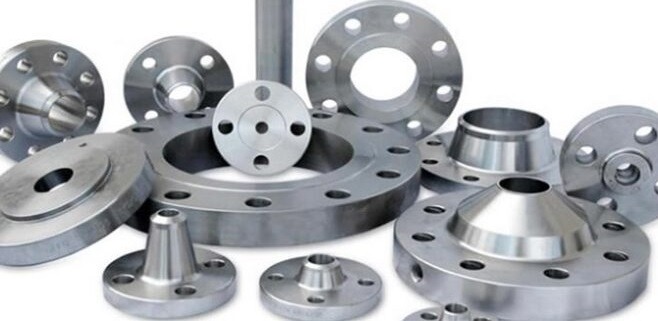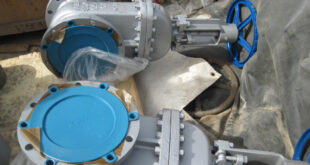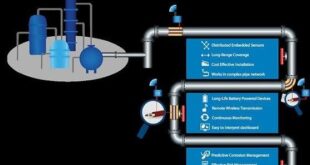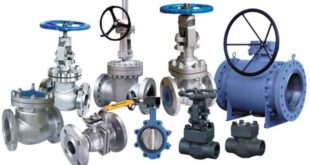What are pipe flanges and how do they work?
Flanges are the second most used connection method after welding, providing a reliable way to connect piping systems to various equipment, valves and other components of almost any process system.
The use of flanges increases flexibility when maintaining piping systems by allowing for easier disassembly and better access to system components.
A typical flange connection consists of three parts:
- Pipe flanges
- Washer or gasket
- bolt and nut
In most cases, there are special gasket and bolt materials that are made from the same or approved material as the pipe components you want to connect. Stainless steel flanges are one of the most common. However, flanges are available in a wide variety of materials, so matching them to your needs is essential.
Other common flange materials include Inconel, Monel, and many others depending on the application.
The best option for your needs depends on both the system in which you plan to use the flange and your specific needs.
Flange types and common features
Flanges are not a one-size-fits-all solution. Regardless of size, matching the ideal flange design to your piping system and intended use will help ensure reliable performance, long life, and optimal pricing.
Here’s a look at the most common types of flanges available.
Threaded flanges
Also known as a bolt-on flange, this style has a rib inside the flange hole that mates with a counter male rib on the pipe or fitting. A threaded connection means you can avoid welding in many cases. Simply match the thread to the pipes you want to connect.

Socket-weld flange
Ideal for smaller pipe diameters in low pressure and low temperature applications, socket weld flanges feature a joint where you insert the pipe into the flange and then secure the joint with a multi-pass filler weld. This makes this style easier to install than other types of welded flanges while avoiding the limitations associated with threaded ends.
Slip-on flanges
Slip-on flanges are very common and are available in a wide range of sizes for use in higher flow rate and power systems. Simply match the flange to the outside diameter of the pipe you want to connect. Installation is a little more technical because you need filler welds on both sides to secure the flange to the pipe.

LAP JOINT flanges
Lap joint flanges, which are of a two-piece design, require butt welding of the head end to the pipe or connection using a back flange to create a flange connection. This design makes this style popular for use in systems with limited physical space or systems that require frequent disassembly and maintenance.

Weld neck flanges
Like lap joint flanges, weld-neck flanges require butt welding for installation. However, their integrity, performance in systems with multiple bends, and their ability to be used in high pressure and high temperature systems make them a leading choice for process piping.

BLIND FLANGES
Blind flanges, used to terminate or isolate piping systems, are basically bolt-on blank discs. When properly installed and combined with the correct gaskets, they can achieve an outstanding seal that can be easily removed when needed.

Special flanges
The flange types listed above are the most common. However, there is a wide range of additional special flange types to suit a wide range of applications and environments. Other options include nipo-flange, weldo-flange, expansion flanges, orifice, long weld neck and reducing flanges.
Types on flanges
Flange design is only the beginning when considering the ideal flange for your piping system. Types of flanges is another feature that will have a great impact on the final performance and useful life of your flanges.
The types of flanges determine both the gaskets required to install the flange and the characteristics of the seal created.
Common types of flange faces are:
Flat Face (FF):
As the name suggests, flat face flanges have a flat, uniform surface with a full face gasket that contacts most of the flange surface.
Raised Face(RF):
These flanges have a small raised section around the hole with an inner hole circle washer.
Ring Type Joint (RTJ):
Used in high pressure and high temperature processes, this type of face has a groove in which a metal gasket is placed to maintain the seal.
Tongue and Groove (T&G):
These flanges have matching grooves and raised sections. This aids installation as the design helps the flanges self-align and provides a reservoir for the gasket adhesive.
Male and Female (M&F):
Similar to tongue-and-groove flanges, these flanges use a pair of grooves and raised sections to secure the gasket. However, unlike tongue-and-groove flanges, these flanges hold the gasket on the face of the material, allowing for more precise placement. and increase gasket material options.
Most face types offer one of two types: serrated or smooth.
Choosing between options is important because they determine the optimal gasket for reliable sealing.
In general, smooth surfaces work best with metal gaskets while serrated surfaces help create stronger seals with soft material gaskets.
Proper fit: Look at the dimensions of the flange
Aside from the functional design of the flange, flange dimensions are the most likely factor influencing flange selection when designing, maintaining, or updating a piping system.
However, you should consider how the flange will fit with the pipe and gaskets used to ensure proper sizing.
Common considerations include:
- Outer diameter: the distance between two opposite edges of the flange face
- Thickness: Measure the thickness of the edge of the outer joint
- Bolt circle diameter: The distance between the holes of the counter-bolt when measured from center to center
- Pipe Size: Determines the pipe size that the flange fits
- Nominal Bore Size: The measurement of the inner diameter of flange fasteners
Flange class and service rating
Each of the above characteristics affects how the flange performs in a wide range of processes and environments.
So how can you tell which flanges are right for the job and which aren’t?
Flanges are often classified based on their ability to withstand temperature and pressure.
This is specified using a number and the suffix “#”, “lb” or “class”. These extensions are interchangeable but will vary by region or vendor.
Common classifications are:
#150
#300
#600
#900
#1500
#2500
Pressure and temperature tolerances vary based on materials used, flange design, and flange size. The only constant is that in all cases, as temperature increases, the pressure rating decreases.
Flange and marking standards
To help in easier comparison, flanges fall under the global standards set by the American Society of Mechanical Engineers (ASME) ASME B16.5 and B16.47.
If you want to replace or verify existing parts, all flanges should be marked – usually on their outer circumference – to aid in this process.
These markings also follow a strict order:
- Manufacturer’s logo or code
- ASTM material code
- Material grade
- Service rating (pressure-temperature class)
- Size
- thickness (application)
- Heat number
- Special designations, if any
This article provides a solid foundation of flange design basics and how to select the ideal flange for your piping system. However, with the wide variety of stainless steel flanges and other flange materials available, it is impossible to list every configuration, detail or consideration.
 Ontrose industrial corporation Inc. Engineering and supply of industrial projects
Ontrose industrial corporation Inc. Engineering and supply of industrial projects





